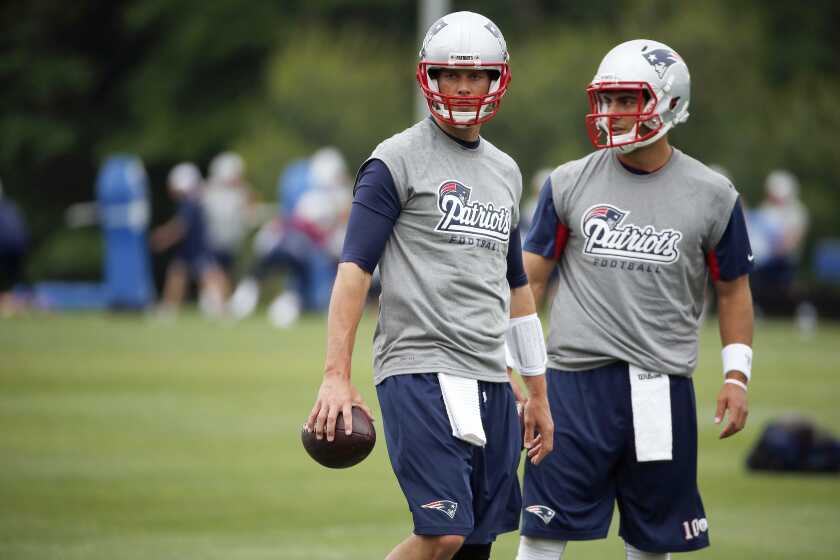Old Dreams Die Hard : Scouts Rule Over Baseball Tryout Camps, Where the Radar Gun Can Kill a Career
A former minor leaguer, a martial arts expert, a baseball fanatic and a positive thinker descended on Loyola Marymount’s Page Stadium last month with batting gloves in their back pockets and hopes higher than the towering left-field screen.
The occasion was a baseball tryout camp for prospective professionals sponsored by the El Toro-based Major League Scouting Bureau.
About 100 ballplayers dreaming of contractual pots of gold showed up. Two-thirds of them were rudely awakened when they were cut before the all-important scrimmage. The remaining third toiled under overcast skies, trying to impress about 10 major league scouts until the tryout ended about 3 p.m.
Rumor had it that one of about 30 pitchers, who were told they would have to throw at least 85 m.p.h. to even be considered, signed a contract. A few other players were seen chatting with scouts after the scrimmage. The rest--and these guys made the cut--received a detached “thank you” from bureau coaches, along with a less-than-enthusiastic “keep working.”
Such tryouts are designed to give players who have not been drafted a chance for exposure and to sign a contract that would pay them about $700 a month for playing in a rookie league until September. Then they would receive their $1,500 signing bonus and perhaps even an invitation to spring training.
The odds, however, are hardly in the players’ favor, thanks to last month’s amateur draft.
“So soon after the draft, there are no spots,” said scout George Genovese of North Hollywood, who scans Southern California for the San Francisco Giants. “Clubs have signed so many guys and all of those guys have to get a chance. You can’t clutter (rookie league) rosters with undrafted players, so until the alarm goes off that a club needs someone, guys who haven’t been drafted get very few opportunities.”
That much was clear to the former minor leaguer, martial arts expert, baseball fanatic and positive thinker.
Yet they tried out anyway. Dreams die hard.
Lee Carballo says he is not upset. “That’s baseball” is a phrase he utters with ease. But hearing him talk at length about his brief stint with the Angels, a listener suspects Carballo, a 6-foot-3, 170-pound, side-arming right-hander, is uneasy.
Carballo, a self-described “pole on the fence” at St. Bernard High, compiled a 12-6 mark the following two years at West L. A. College before laboring for about 100 innings in relief at UC Santa Barbara in 1986 and ’87.
Last June, Angels scout Rick Ingalls signed Carballo and the club assigned him to Palm Springs, the better of two Angel Class-A farm teams. Carballo was 2-1 with two saves and earned an invitation to spring training this year, but he was released despite, he said, pitching well.
The experience was disheartening.
“When you do all right in spring training and you go to your locker and it’s cleaned out and your stuff is in a garbage bag, it’s tough,” he said. “The coaches treat you like a disease once you’re cut. They just don’t want to talk to you.
“It was hard to accept because one pitching coach had told me he thought I had a good chance to stay. But if you can’t take all that with a big heart, then you’d find yourself in a nut house with a straitjacket.”
Ingalls, who said the Angels no longer have any interest in Carballo, suggested that the pitcher got lost in a numbers game that favored younger, harder throwers. Carballo, 22, was competing against 18- to 20-year-olds destined for Class-A ball, but his age dictated that he needed to make the double-A club, Ingalls said.
Still, Carballo’s experience with the Angels bothers him less than the stigmas he believes players receive from self-serving scouts armed with radar guns, two of whom recorded velocities at Loyola.
“If a scout signs the guy who throws 95 m.p.h. and he doesn’t pan out, the scout can say it’s not his fault, it’s the club’s problem,” Carballo said. “But if the scout signs a guy who doesn’t throw 95 but throws in the low 80s, like me, and his ball moves but the guy never pans out, the scout can be told that the guy was never a prospect in the first place.
“The 85 m.p.h. mark is just a label. I talked to Rod Carew once and he said the average speed in the majors was 82-84. That’s what I throw, so why don’t the scouts take that?”
Despite his frustration, Carballo said he will continue to attend scouting camps. He also will pitch for a semipro team, hoping for another chance but recognizing that his release from the Angels surrounds him with doubt.
“If I happen to get signed, great. If not, I’ve got an education,” he said. “Baseball is important but it’s not my life. If I were really upset by what’s happened to me, I wouldn’t be doing this anymore. I’d probably be a serial killer who went around killing all the scouts.”
Matt Diagostine had not picked up a baseball since the Torrance High alumni game in February.
His feet had become more important.
Needing something to replace baseball two years ago, after an incomplete season at El Camino College in which he fell out of favor with Coach Tom Hicks, Diagostine opted for savate, otherwise known as French kick-boxing.
Less than a year later, he had earned a silver glove, the equivalent of a black belt in karate. Now, along with his brother-in-law and a friend, Diagostine teaches savate to about 10 students in a Redondo Beach garage.
Diagostine, 20, wants people to understand that savate is not like the kick-boxing you might have seen on ESPN. “Those are just boxers who learn to kick,” he said. “If you just punch in savate, you get killed. There’s much more kicking.”
There is not, however, any batting, throwing or fielding. So when Diagostine did not have anything else to do last week, he decided to dust off his mitt.
Hours later, at Loyola, he dug his cleats into a muddied field, vacuumed up his share of grounders and fired three strikes to first base from shortstop.
He also went 1 for 2 in the scrimmage, but his arm was rated below the major league average and his 5-9, 165-pound frame received a few frowns.
It did not matter, though. Baseball fever had taken hold. Diagostine was ready to make room for the pursuit he had pushed out of his life two years ago.
“All I need to sign a contract is a plane ticket, a pair of cleats and a place to play,” he concluded.
He knows the chance of obtaining those is slim. But at Loyola, Diagostine discovered that what hurt his baseball future at El Camino--immaturity--had disappeared.
After his senior year at Torrance, he was prepared to play at UC Irvine, where he had been accepted as a student. “But at the last minute,” he recalled, “it didn’t work out. Going to El Camino seemed to me to be a step down and I was bitter, and that was stupid.”
Savate, he says, gave him enough poise and confidence to try out last week without little things--scouts talking to others but not to him, for example--bothering him. And if no opportunities surface in baseball, he thinks fight choreography, stunt work or acting could be in his future.
But, he said, “if a team needed someone somewhere, I’d go.”
Expecting 5-11, 165-pound Mike Villasenor to do much pitching in the pros is probably foolish. Villasenor, however, might be a fool for love.
“I’ll play baseball as long as I love it,” he says, “and I know I’ll love it forever.”
The truth is Villasenor, a baseball fanatic who was named second-team all-league at Torrance High in 1984 and appeared in four games for Cal State Dominguez Hills in 1987, is close to signing a contract. Which doesn’t mean his agent has to iron out the wrinkles in a six-figure deal. It means a few scouts think he can pitch in rookie or Class-A ball. For that, he would be paid the obligatory $700 a month.
At Loyola, Villasenor’s fastball was clocked at 83 m.p.h. on what is known as the “slow” radar gun, meaning his pitches would register about 86 m.p.h. on the “fast” gun. One bureau representative said he was the hardest thrower who tried out.
“Hell, I’d pay them to sign me,” he said, laughing. “I’d take anything someone would offer me now.”
In his corner is Genovese, the Giants scout who has Villasenor hurling for his Southland rookie semipro squad. Genovese is renown for making somebody of a nobody. In 1967, when all the scouts begged off a player at Leuzinger High named George Foster, Genovese signed him a year later. Foster retired two years ago after hitting more than 300 major league home runs and piling up more than 1,100 runs batted in.
Similar stories surround Genovese picks such as Chili Davis, Jack Clark and Royal High’s Eric King, all current major leaguers. “I think Villasenor could go out and pitch right now in the minor leagues,” Genovese said. “He’s not big but he knows how to pitch, and I’d sign him if we could.”
Genovese likens Villasenor to Angels reliever Dewayne Buice, an All-City pitcher at Carson in 1975 who Genovese also signed. Buice, at 5-11 and 170 pounds, is hardly imposing and does not throw especially hard, but that is not important, Genovese said.
“Size is only a factor at the beginning,” he said. “Every scout would like to have the 6-4 guy, but that is nothing if the guy can’t get people out.
“Baseball was around a long time before radar guns and stopwatches, and if a player shows me he can pitch and gets people out, that’s good enough.”
Villasenor showed Genovese this spring that his split-finger fastball and control could get hitters out.
What’s left? Summer league games--and the waiting game. Villasenor, a Hermosa Beach resident who has one semester left at Dominguez Hills, plays both.
“Playing pro ball has been a dream since I was a kid,” he said. “I’ll play until my I get my chance--or my arm falls off.”
Dan Fouts, a former Westchester High and Harbor College first baseman, never thought a book could alter his approach to baseball. But that was before he read Maxwell Maltz’s “Psycho-Cybernetics.”
John Scolinos, the Cal Poly Pomona baseball coach, introduced Fouts to “Psycho-Cybernetics” two years ago. The book touts “visualization,” positive thinking and relaxation as self-improvement aids. Scolinos employs visualization--”you visualize yourself hitting a rocket and then you hit it,” he says--in coaching.
Fouts has found the technique eye-opening.
“Your body doesn’t know the difference between a real situation and a visualized one,” he said, “so if you can visualize it, there is no pressure when it happens.
“I used to always go on feeling when I played. I tried to feel for the pitch. Now I can almost tell what will happen.”
It seemed Fouts could almost tell what was coming at Loyola, where he fouled off about five tough pitches before lofting a long fly ball to right field and ripping a single to right-center in his second at-bat. His aggressiveness at the plate did not go unnoticed.
Neither, however, did his lack of speed and limited range at first base. One scout said simply: “He’s not a prospect.”
“The scouts think I’m a hard worker,” Fouts said sheepishly, “but there is more to me than that. I need a chance to prove myself.”
He has had few chances at Pomona. This season he hit .257 with 2 home runs and 8 RBIs in just 70 at-bats, mostly as a designated or pinch-hitter. Next year the 6-foot, 210-pound senior is likely to compete for the starting job at first base, but there are better bets.
Scolinos’ mental training helps Fouts remain motivated. “Baseball is a failure game,” Fouts said. “It depends on how you handle failure. If you can handle it, you can turn negatives into positives and thrive on pressure situations.”
Fouts thrived in 1983 when his Westchester club captured the City 3-A championship, and in 1984, when he earned second-team all-league honors. Westchester lost to Venice in the 3-A final.
Those memories, he says, are vivid. But like any positive thinker, what lies ahead for Fouts is what counts.
“I feel I do have the tools to play pro ball,” he said, “and I’m gonna work my butt off to earn the chance.”
More to Read
Go beyond the scoreboard
Get the latest on L.A.'s teams in the daily Sports Report newsletter.
You may occasionally receive promotional content from the Los Angeles Times.










